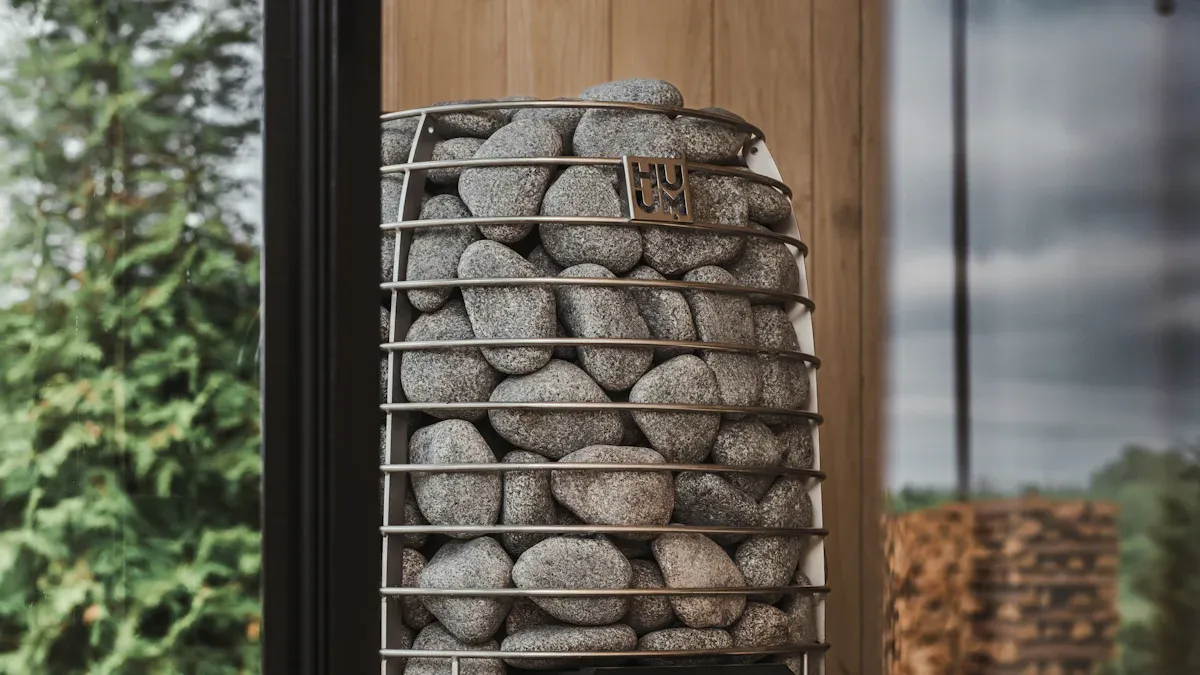
The global sauna services market continues its impressive expansion, projected to grow from $1.07 billion in 2024 to $1.18 billion in 2025. This growth highlights the increasing demand for personalized wellness experiences at home. Selecting the correct sauna heat element is a crucial decision for homeowners. The ideal Heating Element depends on an individual’s preference for heat type, their budget, and the home’s specific installation capabilities. Heating element manufacturers, such as Jinzhong Electric Heating, continuously innovate with new household appliance heating elements. Ultimately, the choice for any sauna comes down to three primary technologies.
- Traditional Electric
- Infrared
- Wood-Burning
Understanding Your Sauna Heat Element Options

Choosing the right sauna heat element is the most critical step in defining your home wellness experience. Each technology offers a distinct type of heat, carries different installation requirements, and operates with unique principles. The primary options are traditional electric heaters, modern infrared emitters, and classic wood-burning stoves.
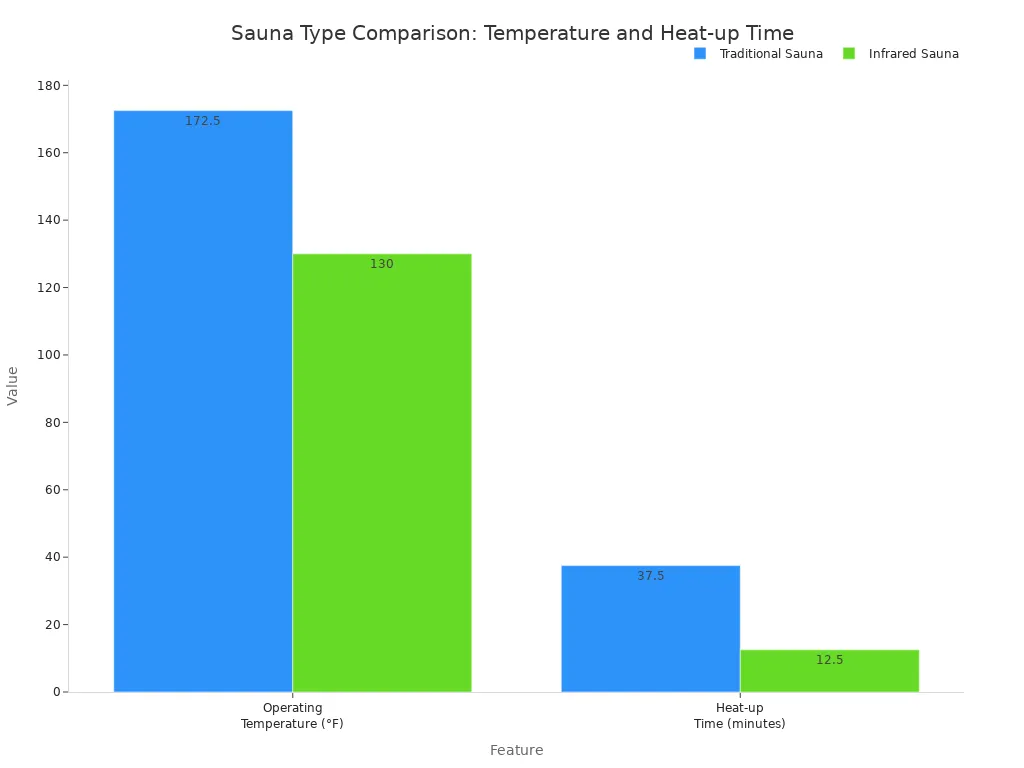
Traditional Electric Heaters
Traditional electric heaters are the most common choice for modern residential saunas, offering a balance of convenience and classic performance.
How They Work
These units use electric heating elements to warm a compartment of sauna rocks. The heater raises the ambient air temperature inside the sauna to between 150°F and 195°F. Users can then ladle water onto the hot rocks. This action produces a burst of steam, known as löyly in Finnish, which significantly increases the room’s humidity and intensifies the feeling of heat.
Best For
An electric heater is ideal for individuals who desire a classic sauna experience with modern convenience. Users who enjoy high temperatures and the ability to create steam will find this option perfect. Its simple, switch-based operation and digital controls offer precise temperature management with minimal effort.
Key Considerations
While convenient, these heaters have specific requirements. Most residential electric heating elements demand a dedicated 240V circuit, which often requires professional installation. Power consumption is another factor. A typical unit consumes around 6 kW while heating up and settles to 3-4 kW during use, which will impact utility bills. Sizing the heater correctly is crucial for efficiency.
| Heater Wattage (kW) | Recommended Room Volume (cubic feet) |
|---|---|
| 4 | Up to 200 |
| 6 | 250-450 |
| 8 | 350-700 |
Infrared Emitters
Infrared technology provides a different kind of sauna experience, focusing on heating the body directly rather than the air.
How They Work
Infrared emitters use light waves to warm the user’s body from within. This method is highly efficient, allowing the sauna to operate at much lower and more comfortable temperatures, typically between 120°F and 140°F. There are three main types of infrared wavelengths:
- Near-Infrared (NIR): Uses the shortest wavelengths to penetrate the skin’s surface, often used for skin health benefits.
- Mid-Infrared (MIR): Reaches deeper into the body’s soft tissues.
- Far-Infrared (FIR): Has the longest wavelength, penetrating up to 1.5 inches below the skin to heat muscles and joints. Most therapeutic infrared saunas prioritize FIR emitters.
Best For
Infrared saunas are an excellent choice for users sensitive to high heat or those seeking targeted therapeutic benefits. The gentle warmth allows for longer, more comfortable sessions, making it easier to read or meditate. Individuals focused on deep tissue relief, detoxification, and improved muscle recovery often prefer infrared technology.
Key Considerations
The primary difference is the experience itself. An infrared sauna does not produce steam and lacks the intense, enveloping heat of a traditional sauna. While research supports many health benefits, long-term cardiovascular studies are more extensive for traditional saunas. On the plus side, infrared heating elements are exceptionally energy-efficient and usually operate on a standard 120V household outlet, simplifying installation.
Wood-Burning Stoves
Wood-burning stoves offer the most authentic and rustic sauna experience, connecting users to the origins of the practice.
How They Work
A wood-burning stove operates by burning firewood in a firebox to heat the body of the stove and the rocks piled on top. Like an electric heater, it heats the air in the room to high temperatures. Users can also pour water over the rocks to generate powerful steam. This method is completely off-grid, relying only on a supply of wood.
Best For
This option is for the traditionalist. Individuals who appreciate the ritual of building a fire, the scent of burning wood, and a powerful, radiant heat will find wood-burning stoves unmatched. They are perfect for cabins, rural properties, or any outdoor sauna where electricity is unavailable or undesirable.
Key Considerations
Wood-burning stoves require the most significant infrastructure and effort. A proper chimney system for ventilation is mandatory for safety. They also demand substantial clearance from combustible materials and a non-combustible floor protector. The user is responsible for sourcing and storing firewood, lighting the fire, and performing regular maintenance, including ash removal and chimney sweeping.
Heat Performance: What Kind of Warmth Do You Want?
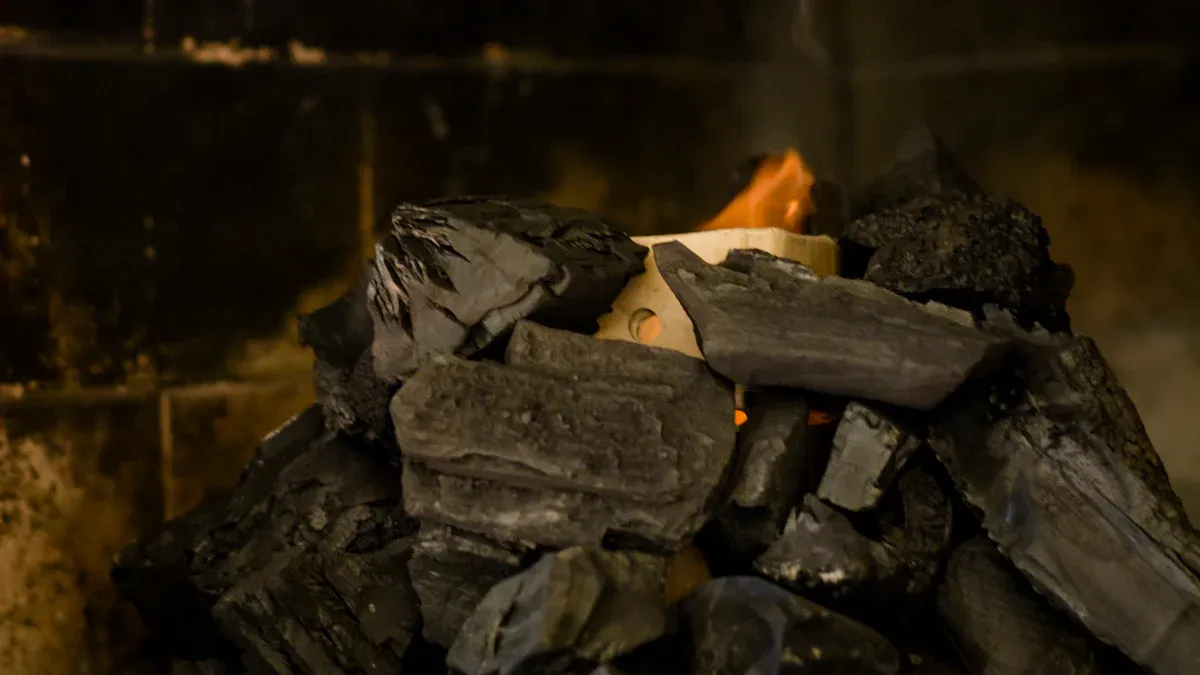
The performance of a sauna heat element directly shapes the user’s experience. Factors like how quickly the sauna becomes usable and the specific character of the warmth are critical decision points. Each heating technology delivers a distinct thermal profile, catering to different preferences for speed, temperature, and sensation.
Heat-Up Time Comparison
The time it takes to go from a cold start to a ready-to-use sauna varies significantly between heater types. This waiting period is an important lifestyle consideration for many users.
| Heater Type | Average Heat-Up Time | Key Factor |
|---|---|---|
| Electric | 30–45 minutes | Heats the air and rocks |
| Infrared | 10–20 minutes | Heats the body directly |
| Wood-Burning | 45–60+ minutes | Depends on fire management |
Electric Heater Speed
An electric heater must warm the entire volume of air in the sauna, along with a large mass of rocks. This process typically takes 30 to 45 minutes to reach the desired operating temperature. Users must plan their sessions in advance to accommodate this pre-heating cycle.
Infrared Emitter Speed
Infrared emitters offer the fastest path to starting a session. An infrared sauna can exceed 100°F within 15 minutes. The infrared energy begins to emit immediately upon activation, warming the user’s body directly. This means a person can begin their session almost right away, even before the cabin air reaches its peak temperature.
Wood Stove Speed
A wood-burning stove has the most variable and longest heat-up time. Users must build and tend a fire until it generates enough heat to warm the stove and rocks. This process can take anywhere from 45 minutes to over an hour, depending on the wood quality, stove size, and outdoor conditions.
Temperature Range and Feel
The type of warmth is just as important as the temperature. Each heater creates a unique environment, from steamy and intense to gentle and penetrating.
High Heat and Löyly with Electric
Electric heaters excel at creating the classic Finnish sauna experience. They produce high ambient air temperatures, typically between 150°F and 195°F. The defining feature is the ability to generate löyly, or steam, by ladling water onto the hot rocks. This action provides a wave of humid heat that many traditionalists seek.
Deep Warmth with Infrared
Infrared technology provides a gentle, therapeutic warmth. The emitters operate at a much lower air temperature, usually 120°F to 140°F. Instead of heating the air, infrared waves penetrate the body, creating a deep warmth from within. This allows for longer, more comfortable sessions without the intense heat of a traditional sauna.
Note: The infrared experience is entirely dry. It does not involve steam, focusing instead on direct-to-body heat transfer for deep muscle and joint relief.
Authentic Dry Heat with Wood
A wood stove produces a powerful, radiant heat that many users describe as softer and more pleasant than electric heat. It effectively heats the air to high temperatures, similar to an electric unit. It also provides an exceptional löyly when water meets the superheated rocks, delivering what many consider the most authentic and robust steam experience available.
Installation: What Does Your Space Allow?
A homeowner’s existing space and infrastructure are primary factors in selecting a sauna heat element. The installation process ranges from simple plug-in setups to complex projects requiring professional contractors. Understanding the electrical, venting, and spatial requirements is essential before making a purchase.
Electrical Requirements
The power source is often the first logistical hurdle. Different heating technologies have vastly different electrical demands.
240V Circuits for Electric Heaters
Traditional electric heaters are powerful appliances. They almost always require a dedicated 240V circuit, similar to an electric stove or clothes dryer. A licensed electrician typically performs this installation. Key electrical specifications include:
- Voltage: Most units run on 240 volts.
- Circuit Breaker Size: Breakers range from 30 to 60 amps, depending on heater wattage.
- Wire Gauge: A #10 to #6 AWG wire is standard, based on the amperage draw.
120V Plug-in for Infrared Panels
Infrared saunas offer significant installation advantages. Most infrared panels and pre-built cabins are designed for energy efficiency. They operate on a standard 120V household outlet, eliminating the need for costly electrical work. This plug-and-play convenience makes them a popular choice for easy home integration.
Venting and Safety Clearances
Proper ventilation and spacing are non-negotiable for safety and performance. Every heater type has specific needs to ensure safe operation.
Chimney Needs for Wood Stoves
Proper ventilation is critical for wood-burning stoves. They require a dedicated chimney system to safely exhaust smoke and combustion gases from the sauna. Installation must adhere to local building codes and manufacturer specifications.
Safety Clearances for All Types
All sauna heaters produce intense heat and require a buffer zone to prevent fire hazards. Manufacturers provide precise minimum clearance distances from walls, ceilings, and benches. These distances must be respected for both combustible and non-combustible surfaces.
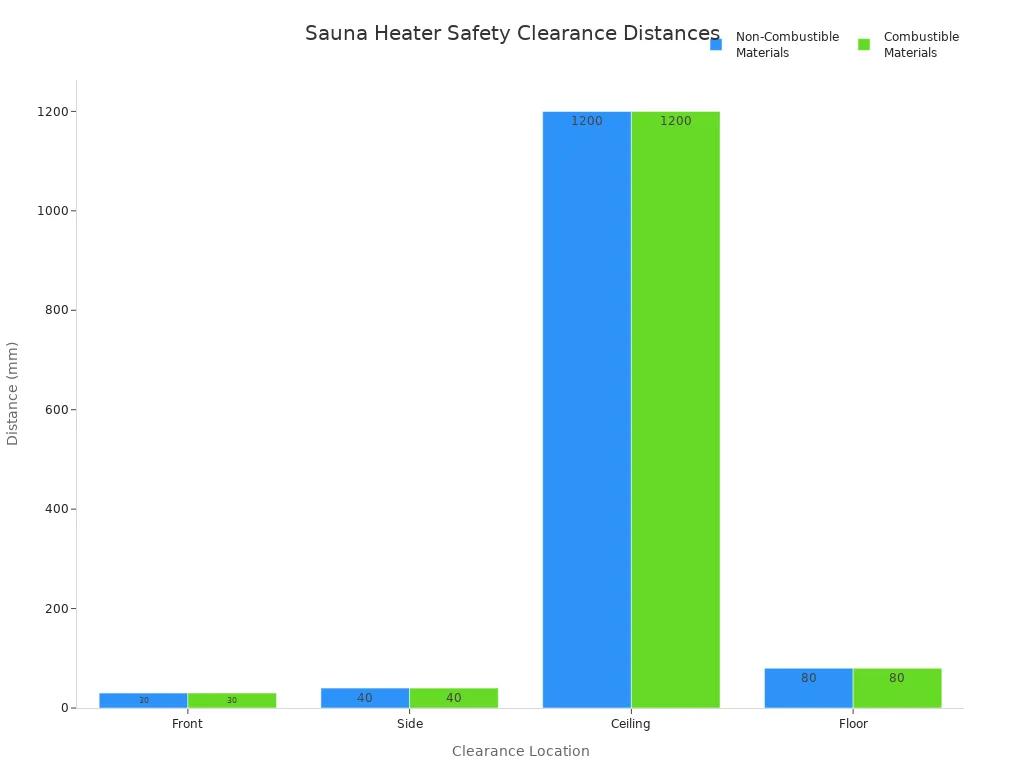
Footprint and Placement
The physical size and location of the heater impact the sauna’s interior layout and functionality.
Wall-Mounted vs. Floor-Standing
Electric and wood heaters come in two main styles. Wall-mounted units are great for smaller rooms because they conserve floor space. Floor-standing models often have a larger rock capacity for better steam and serve as a central feature of the room.
Strategic Placement of Infrared Panels
Infrared heating relies on the strategic placement of multiple emitters. Panels are typically installed on the walls, under the bench, and sometimes on the floor. This configuration ensures the user’s body receives 360-degree coverage for the most effective and even deep-tissue warmth. ♨️
Cost Analysis: Upfront Price vs. Long-Term Operating Costs
A comprehensive cost analysis involves looking beyond the sticker price to understand the total cost of ownership. The initial purchase price, ongoing operating expenses, and energy efficiency all play significant roles in the financial commitment to a home sauna.
Initial Purchase Price
The upfront investment for a sauna heater varies widely based on technology, build quality, and features.
Entry-Level vs. Premium Heaters
Heater prices scale with materials and technology. Entry-level models provide basic functionality. Premium heaters often feature stainless steel construction, larger rock capacities, and advanced digital or Wi-Fi controls, which increase their initial cost.
Cost Comparison by Heater Type
Each heater type occupies a different price bracket. Electric sauna heaters typically boast the lowest initial costs. They only require access to electrical power for installation. Wood-burning heaters have higher upfront costs, largely due to the complex and labor-intensive chimney setup they demand. Infrared saunas present a wide cost range. A modular infrared sauna unit generally costs between $6,000 and $10,000. A custom-built infrared sauna can see prices from $10,000 to $40,000 after professional installation.
Long-Term Operating Costs
The daily or weekly cost to run your sauna is a critical long-term budget consideration.
Electricity Usage of Heating Elements
Infrared heaters are significantly more economical to operate than their traditional electric counterparts. The difference in power consumption directly impacts utility bills.
| Appliance | Typical Wattage | Cost for 1 Hour Use (at $0.13/kWh) |
|---|---|---|
| Traditional Electric Sauna | 6000W | $0.78 |
| Infrared Sauna | 1800W | $0.23 |
Note: A traditional electric sauna uses powerful 6000-9000 watt heating elements to heat the air. An infrared sauna uses more efficient 1500-2500 watt emitters to heat the body directly, resulting in lower energy use.
The Ongoing Cost of Firewood
For wood-burning stoves, the primary operating cost is firewood. This expense varies based on your location and whether you purchase pre-cut cords or source the wood yourself. It represents a consistent, non-electric cost.
Energy Efficiency in 2025
Manufacturers continue to innovate, pushing for greater efficiency to lower operating costs and environmental impact.
Efficiency of Infrared Heating Panels
Infrared heating panels remain the leader in energy efficiency. They consume roughly one-third of the electricity of traditional heaters and offer much faster heat-up times. This efficiency makes them an attractive option for frequent users concerned with energy consumption.
Modern Electric Heater Efficiency
Modern electric heaters are closing the efficiency gap with new technologies. Key advancements for 2025 include:
- Advanced Materials: Graphene and aviation-grade carbon fiber in heating elements offer superior thermal conductivity, reducing energy waste.
- Smart Technology: IoT integration allows for app-based controls and AI-assisted scheduling. These systems optimize energy use by heating the sauna precisely when needed.
- Hybrid Systems: Some new models combine heating technologies, giving users a customizable experience with a more flexible energy profile.
Maintenance and Lifespan of Your Heating Elements
Proper care is essential for maximizing the performance and lifespan of any sauna heater. Consistent sauna maintenance ensures safety, efficiency, and a quality experience for years to come. Each heater type has unique upkeep requirements.
Routine Upkeep by Type
Regular cleaning and inspection prevent minor issues from becoming major problems. Users should always disconnect power and ensure the unit is completely cool before performing any sauna maintenance.
Replacing Sauna Rocks
Sauna stones are a critical component in traditional saunas. Users should inspect their sauna stones annually. Over time, heating and cooling cycles cause the rocks to crack and crumble. This grit can damage the heating elements below. It is best practice to remove the sauna stones once a year for cleaning and to check the elements for debris. Replace the rocks after about 300 hours of use or when they show signs of deterioration.
Cleaning Infrared Emitters
Infrared saunas require minimal upkeep. The emitters do not have direct contact with water or rocks. A simple wipe-down with a soft, damp cloth is usually sufficient to remove any dust or smudges from the protective covers. This simple task keeps the emitters operating at peak efficiency.
Ash Removal and Chimney Sweeping
Wood-burning stoves demand the most hands-on attention.
- Ash Removal: Users must remove ash from the firebox regularly to ensure proper airflow for efficient combustion.
- Stove Inspection: A monthly check of the stove body for cracks or rust is a wise precaution.
- Chimney Cleaning: The chimney requires annual inspection and sweeping to remove creosote buildup, a significant fire hazard.
Expected Lifespan and Durability
The durability of a sauna heater varies significantly by type. A well-maintained unit will provide reliable service for many years. The initial investment often correlates with the expected longevity of the heating elements.
| Heater Type | Average Expected Lifespan (Years) |
|---|---|
| Electric Heating Elements | 7-12 |
| Infrared Heater Panels | 15-20 |
| Wood-Burning Stoves | 30+ |
Longevity of Electric Heating Elements
The electric heating elements inside a traditional heater are the parts that experience the most wear. With proper care, including correct placement of sauna stones to avoid bending the coils, these components typically last between 7 and 12 years before a replacement is needed.
Durability of Infrared Panels
Infrared panels are known for their impressive durability. Since they operate at lower temperatures and have no moving parts, high-quality carbon or ceramic emitters can last for 15 to 20 years. This longevity makes them a reliable long-term investment for any sauna.
Robustness of Wood Stoves
A well-maintained wood stove is built to last a lifetime. The simple, robust construction from heavy-gauge steel or cast iron can endure decades of use. With routine care, these heaters can easily surpass 30 years of service, making them the most durable option available.
Key Features for Your 2025 Sauna Heater
An excellent sauna heater combines superior materials, intuitive controls, and robust safety mechanisms. Beyond just generating heat, the right unit enhances the entire sauna experience through thoughtful design and engineering. As technology evolves, the features available in 2025 offer users unprecedented control over their wellness environment. Understanding these key features is crucial for making an informed purchase.
Heater Materials and Build Quality
The materials used in a heater’s construction directly influence its durability, performance, and safety. High-quality components ensure longevity and consistent heat delivery.
Stainless Steel Construction
High-grade stainless steel is an excellent material for traditional electric and wood-burning sauna heaters. Its melting point is in the thousands of degrees Fahrenheit, ensuring it does not volatilize or emit particles at normal sauna operating temperatures. This inherent stability makes it a superior choice. Furthermore, stainless steel offers exceptional resistance to rust and corrosion, which is vital in the high-heat, high-humidity environment of a traditional sauna. Manufacturers frequently choose it for critical components like the heater body and chimney, highlighting its durability in demanding conditions.
Carbon Emitters for Even Heat
Carbon emitters are a hallmark of modern infrared saunas. These heaters utilize large carbon fiber panels to produce infrared waves. This design provides several key advantages:
- Even Heat Distribution: The large surface area of carbon panels delivers gentle, consistent warmth across the entire sauna, eliminating the concentrated “hotspots” common with other emitter types.
- High-Quality Wavelength: Carbon emitters are highly effective at producing far-infrared wavelengths, which are ideal for deep body penetration.
- Lower Surface Temperature: They operate at a much lower surface temperature (around 140°F–150°F), allowing users to sit closer comfortably and enjoy a more relaxing session.
Ceramic Emitters for High Intensity
Ceramic emitters use ceramic rods to generate powerful, focused infrared heat. They are known for their high intensity and rapid heat-up times.
| Attribute | Carbon Infrared Heater | Ceramic Infrared Heater |
|---|---|---|
| Heat Distribution | Uniform, gentle coverage | Targeted, intense heat |
| Surface Temperature | 140–150°F | 350–400°F |
| Heat Intensity | Milder, lower power output | Strong, high radiation efficiency |
| Ideal Use Case | Full-body relaxation | Targeted therapeutic sessions |
While ceramic heaters produce a robust and invigorating heat, their focused output can sometimes feel harsh or create uneven heating if not properly placed. They excel in smaller infrared saunas where targeted, high-intensity heat is the primary goal.
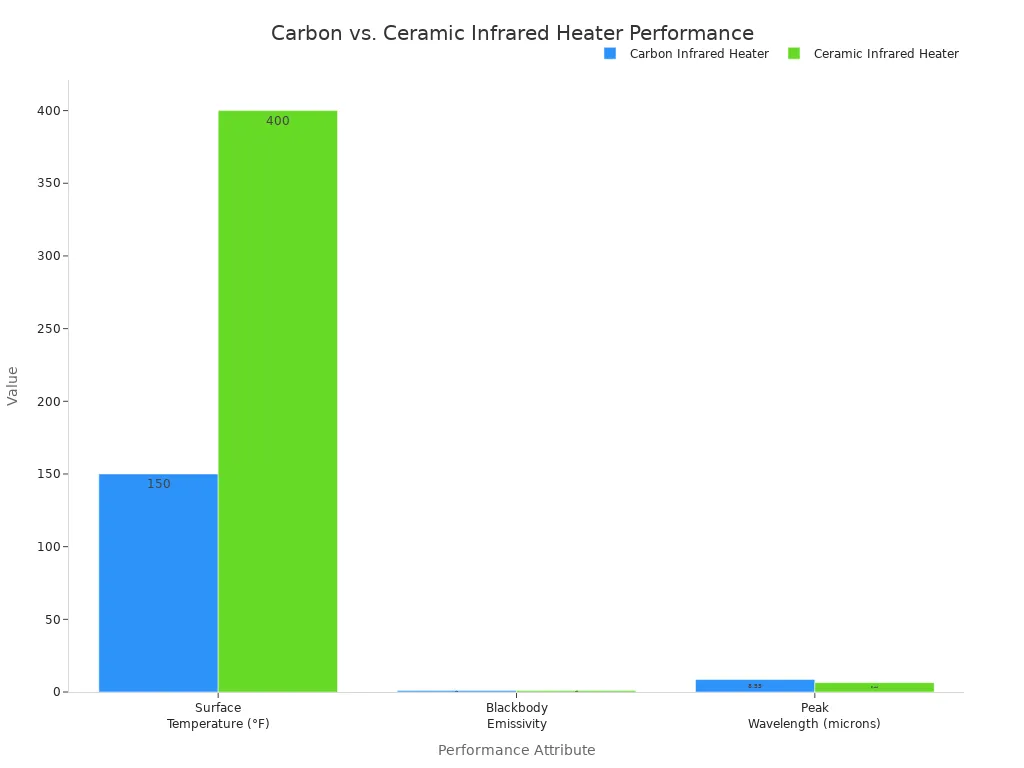
Modern vs. Manual Control Systems
The control system is the user’s primary interface with their sauna. The choice between a modern digital system and a traditional manual one comes down to a preference for convenience versus simplicity.
Digital and Wi-Fi Controls
Modern digital controls, especially those with Wi-Fi connectivity, offer a new level of convenience and precision. Popular features for 2025 include:
- Remote Operation: Smartphone apps allow users to pre-heat their sauna from anywhere.
- Precision Temperature: Set and maintain the exact desired temperature for a consistent experience.
- Scheduling: Program the sauna to be ready at a specific time each day.
- Atmosphere Control: Adjust integrated lighting and fans to customize the environment.
- Smart Learning: Some systems learn user preferences over time to personalize the sauna experience.
These sleek, intuitive interfaces, often featuring touch screens, provide comprehensive management of the sauna environment.
Simple and Reliable Manual Controls
Manual controls offer a straightforward, dependable alternative to complex digital systems.
These systems typically use one dial for temperature and another for a timer. Their primary benefits are durability and ease of use. With fewer electronic components, there is less that can fail, making them a robust choice for users who value reliability and simplicity above all else.
Essential Safety Features
Safety is the most important consideration for any sauna. Reputable manufacturers build multiple safety layers into their products to protect users and property.
The Importance of UL & ETL Marks
Certifications from independent testing laboratories like UL (Underwriters Laboratories) and ETL (Electrical Testing Laboratories) are crucial. These marks confirm that a product conforms to established North American safety standards.
| Certification | Scope of Safety Standards |
|---|---|
| ETL | North American safety standards |
| UL | U.S. and Canadian safety norms |
Purchasing a heater with a UL or ETL mark provides peace of mind that it has undergone rigorous testing for electrical and fire safety.
High-Temperature Shut-Off Sensors
A high-temperature shut-off is a non-negotiable safety feature. This sensor automatically cuts power to the heating elements if the temperature inside the sauna exceeds a preset safety limit. The process works in a few simple steps:
- A sensor continuously monitors the temperature near the heating elements.
- If the temperature surpasses the factory-set limit, the sensor activates a switch.
- The switch interrupts the power supply, stopping the heater from getting any hotter.
- Many systems require a manual reset, which forces the user to acknowledge the overheating event before using the sauna again.
This mechanism is a critical defense against malfunction and fire risk.
Protective Guards and Fencing
A physical barrier around the heater is essential, especially for traditional electric and wood-burning models. A protective guard or fence prevents accidental contact with the hot surfaces of the heater and rocks. These guards are designed to respect the manufacturer’s required safety clearances, ensuring proper airflow while creating a safe zone within the sauna.
Choosing and Replacing Your Sauna Heat Element
Even the most durable sauna components require eventual replacement. Knowing when and how to replace a heating element ensures continued safety and performance for any sauna. This process involves recognizing the signs of failure and correctly identifying the right replacement part.
When to Replace Your Heater Element
A heating element can fail suddenly or degrade over time. Users should be aware of the symptoms of a failing unit and also consider the benefits of a proactive upgrade.
Signs of a Failing Element
A failing element often presents clear symptoms that signal a need for inspection or replacement. A burned-out heater element is a common issue, often requiring disassembly to check for visible damage or test for electrical continuity. Key indicators include:
- The sauna does not heat up properly or takes much longer than usual.
- Visible signs of damage on the heating elements, such as cracks, breaks, or bulging.
A more urgent sign is a distinct smell. When the sauna is warming up, a smell of burning wires coming from the heaters is a serious warning that requires immediate attention.
Upgrading for Better Performance
Replacing an element is also an opportunity to enhance the sauna experience. A user might choose to upgrade an older element to a newer model for improved energy efficiency or faster heat-up times. Upgrading can also be a way to subtly change the heat profile of the room, depending on the materials and design of the new component.
Finding the Right Replacement Part
Sourcing the correct replacement part is critical for a successful repair. Mismatched components can pose a safety risk or simply fail to work.
Matching Brand and Model
To ensure a seamless fit and optimal performance, users must select a compatible part. The following steps guide the selection process:
- Consider the material. Stainless steel is durable and corrosion-resistant. Incoloy offers superior oxidation resistance and quick heating times.
- Think about the design. Tubular heaters provide consistent heat distribution, while fin heaters offer efficient heat transfer.
- Ensure compatibility. The most important step is to check that the voltage, wattage, and physical dimensions of the new element match the specifications for your sauna heater.
Understanding Wattage and Voltage
Wattage and voltage are non-negotiable specifications. The voltage of the new element must match the circuit powering the sauna. The wattage determines the heater’s power output and must be appropriate for the room’s volume.
| Sauna Size | Recommended Wattage |
|---|---|
| Small to medium | 1500W to 4500W |
| Larger saunas | 6000W to 9000W |
Choosing the correct wattage ensures the sauna can reach and maintain its target temperature efficiently.
Ultimately, choosing the right sauna heat element comes down to personal preference. A person must decide between the classic, steamy heat of a traditional electric unit, the deep, therapeutic warmth of infrared panels, or the rustic authenticity of wood-burning stoves. The ideal heater aligns with individual comfort levels, installation capabilities, and budget constraints. This guide provides a comprehensive checklist, empowering homeowners to confidently select the perfect heart for their new sauna.
FAQ
Which sauna heater is the most energy-efficient?
Infrared heaters offer the best energy efficiency. They use significantly less power than traditional electric heaters because they heat the body directly instead of the entire room. This efficiency leads to lower operating costs for frequent users.
Can a homeowner install a sauna heater?
Installation depends on the heater type.
- Infrared: Most operate on a standard 120V outlet, allowing for simple DIY setup.
- Electric: These require a 240V circuit, so a licensed electrician should perform the installation for safety and code compliance.
How often should a user replace sauna rocks?
Users should replace sauna rocks approximately every 300 hours of use or when they show visible signs of cracking. Annual inspection and cleaning of the rocks are best practices to protect the heating elements from debris.
What is the main difference between infrared and traditional heat?
The primary difference is how they deliver warmth. A traditional sauna heats the air to high temperatures, creating an intense, steamy environment. An infrared sauna uses light waves to warm the body directly at lower, gentler air temperatures.
Is a wood-burning sauna safe for indoor use?
A wood-burning stove can be safe indoors if installed correctly. It requires a professional chimney installation for proper ventilation and strict adherence to all manufacturer-specified safety clearances from combustible materials. Always check local building codes.
Which heater type has the lowest long-term operating cost?
Infrared heaters generally have the lowest operating costs due to their superior energy efficiency. A wood-burning stove’s cost varies based on firewood prices. Traditional electric heaters typically have the highest electricity consumption per session.
What do UL and ETL certifications mean?
UL (Underwriters Laboratories) and ETL (Electrical Testing Laboratories) are independent safety certifications. A heater with these marks has been rigorously tested to meet North American safety standards for fire and electrical hazards, ensuring a safer product.


